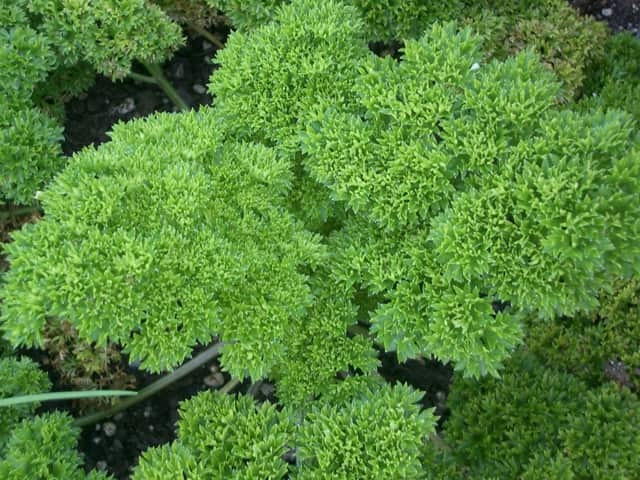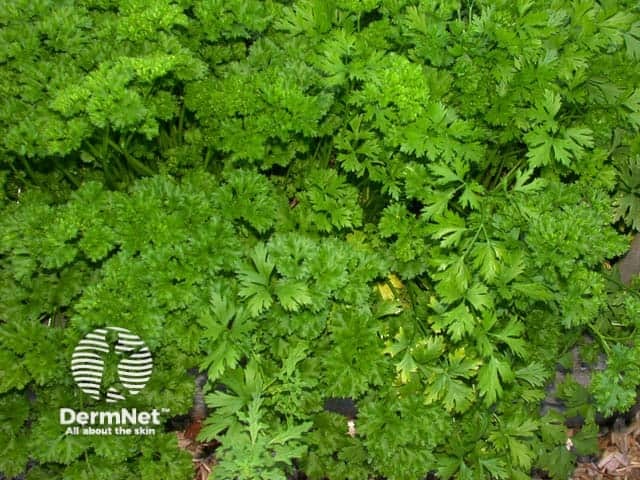Main menu
Common skin conditions

NEWS
Join DermNet PRO
Read more
Quick links
Common name: |
Parsley (Italian parsley, Hamburg parsley, turnip-rooted parsley) |
|
Botanical name: |
Petroselinum crispum (syn. Apium petroselinum, Carum petroselinum, Petroselinum hortense, Petroselinum sativum, Petroselinum vulgare) |
|
Family: |
Umbelliferae or Carrot family. Also known as the Apiaceae, this family is made up of 2850 species in 275 genera. |
|
Origin: |
Originated in the Mediterranean (possible Sardinia) around 2,000 years ago. It is now of cosmopolitan distribution although found chiefly in north temperate regions. |
|
Description: |
Parsley is a clump-forming biennial growing to about 30 cm high and twice as wide. It has bright green multi-compound curly or flat leaves. The leaflets are finely divided and held at the end of long stems and the whole plant has a rounded, mound-like shape. In its second summer, parsley sends up stalks with compound umbels of small yellow flowers. There are three types of commonly used parsley: flat leafed or French Parsley (Petroselinum Crispum French), normal parsley (Petroselinum Crispum) and Hamburg Parsley (Petroselinum Crispum var. Tuberosum). |
|


Uses: |
Flavorant, spice flavourings, and herb. In the kitchen, parsley seems to help blend other flavours. It ameliorates strong odours like garlic and fish. It works well with most foods except sweets. It is a principal ingredient in Middle Eastern tabbouleh. The Japanese deep fry parsley in tempura batter. The British make parsley jelly. The Mexicans use it in salsa verde. The French use it in everything. The Germans are especially fond of the root parsleys. Both roots and leaves can be used. Oil, obtained by steam distillation of ripe seeds of the herb, may be used for flavouring. Also produces oleoresin. Because of its high chlorophyll content, parsley makes an excellent breath freshener. Parsley has been used as a medicinal herb since the Middle Ages, but there is little evidence to support its effectiveness other than its value as a natural vitamin supplement. |
|
Allergens: |
Terpens and probable furacoumarins. |
|
Allergy: |
Phototoxic and allergic contact dermatitis have all been reported like other umbeliferae. A hand dermatitis has been described in a sandwich maker. It has been reported to cause both nasal and eye itchiness as well as throat and laryngeal oedema. Cases of anaphylaxis, angioedema and urticaria have been reported. |
|
Cross reactions: |
Umbeliferae |
|
Other information: |
Parsley was reputed to have sprung from the blood of a Greek hero, Archemorus (Achromous), the herald of death. The ancient Greeks held it in high esteem, crowning the victors with chaplets of Parsley at the Isthmian games, and making wreaths with which they adorned the tombs of their dead. The herb was never brought to table of old, being held sacred to oblivion and to the dead. Greek gardens were often bordered with Parsley and Rue. |
|
Patch test: |
As is |
|